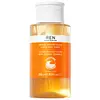What's inside
What's inside
 Key Ingredients
Key Ingredients

 Benefits
Benefits

 Concerns
Concerns

 Ingredients Side-by-side
Ingredients Side-by-side

Water
Skin ConditioningSodium Lactate
BufferingLactic Acid
BufferingHeptyl Glucoside
Potassium Azeloyl Diglycinate
Skin ConditioningTriethyl Citrate
MaskingGlyceryl Caprylate
EmollientSalix Nigra Bark Extract
Skin ProtectingBenzoic Acid
MaskingCitrus Nobilis Peel Oil
MaskingCitrus Aurantium Dulcis Flower Oil
AstringentCitrus Grandis Peel Oil
MaskingCitrus Tangerina Peel Oil
MaskingHeptanol
PerfumingParfum
MaskingLimonene
PerfumingWater, Sodium Lactate, Lactic Acid, Heptyl Glucoside, Potassium Azeloyl Diglycinate, Triethyl Citrate, Glyceryl Caprylate, Salix Nigra Bark Extract, Benzoic Acid, Citrus Nobilis Peel Oil, Citrus Aurantium Dulcis Flower Oil, Citrus Grandis Peel Oil, Citrus Tangerina Peel Oil, Heptanol, Parfum, Limonene
Water
Skin ConditioningGluconolactone
Skin ConditioningNiacinamide
SmoothingGlycerin
HumectantPropylene Glycol
HumectantLactic Acid
BufferingEthoxydiglycol
HumectantMagnesium Chloride
Malic Acid
BufferingArctium Lappa Root Extract
Skin ConditioningCochlearia Armoracia Root Extract
MaskingQuillaja Saponaria Bark Extract
CleansingArnica Montana Flower Extract
MaskingCapsicum Frutescens Fruit Extract
Skin ConditioningPhytic Acid
Citric Acid
BufferingSodium Lactate
BufferingAllantoin
Skin ConditioningSerine
MaskingSulfur
AntiseborrhoeicVinegar
Sodium Salicylate
PreservativeSorbitol
HumectantTea-Lactate
HumectantUrea
BufferingSodium Benzoate
MaskingSodium Bisulfite
AntioxidantWater, Gluconolactone, Niacinamide, Glycerin, Propylene Glycol, Lactic Acid, Ethoxydiglycol, Magnesium Chloride, Malic Acid, Arctium Lappa Root Extract, Cochlearia Armoracia Root Extract, Quillaja Saponaria Bark Extract, Arnica Montana Flower Extract, Capsicum Frutescens Fruit Extract, Phytic Acid, Citric Acid, Sodium Lactate, Allantoin, Serine, Sulfur, Vinegar, Sodium Salicylate, Sorbitol, Tea-Lactate, Urea, Sodium Benzoate, Sodium Bisulfite
 Reviews
Reviews

Alternatives
Ingredients Explained
These ingredients are found in both products.
Ingredients higher up in an ingredient list are typically present in a larger amount.
Lactic Acid is another well-loved alpha hydroxy acid (AHA). It is gentler than glycolic acid but still highly effective.
Its main role is to exfoliate the surface of the skin by loosening the “glue” that holds dead skin cells together. Shedding those old cells leads to smoother, softer, and more even-toned skin.
Because lactic acid molecules are larger than glycolic acid, they don’t penetrate as deeply. This means they’re less likely to sting or irritate, making it a great choice for beginners or those with sensitive skin.
Like glycolic acid, it can:
Lactic acid also acts as a humectant (like hyaluronic acid). It can draw water into the skin to improve hydration and also plays a role in the skin's natural moisturizing factor (NMF) in the form of sodium lactate.
Studies show it can boost ceramide production to strengthen the skin barrier and even help balance the skin’s microbiome.
To get results, choose products with a pH between 3-4.
Lower strengths (5-12%) focus on surface exfoliation; higher strengths (12% and up) can reach deeper in the dermis (deeper, supportive layer) to improve skin texture and firmness over time.
Though it was originally derived from milk, most modern lactic acid used in skincare is vegan. It is made through non-dairy fermentation to create a bio-identical and stable form suitable for all formulations.
When lactic acid shows up near the end of an ingredient list, it usually means the brand added just a tiny amount to adjust the product’s pH.
Legend has it that Cleopatra used to bathe in sour milk to help reduce wrinkles.
Lactic acid is truly a gentle multitasker: it exfoliates, hydrates, strengthens, and brightens. It's a great ingredient for giving your skin a smooth, glowing, and healthy look without the harshness of stronger acids.
Read more about some other popular AHA's here:
Learn more about Lactic AcidSodium Lactate is the sodium salt of lactic acid, an AHA. It is a humectant and sometimes used to adjust the pH of a product.
This ingredient is part of our skin's NMF, or natural moisturizing factor. Our NMF is essential for the hydration of our top skin layers and plasticity of skin. NMF also influences our skin's natural acid mantle and pH, which protects our skin from harmful bacteria.
High percentages of Sodium Lactate can have an exfoliating effect.
Fun fact: Sodium Lactate is produced from fermented sugar.
Learn more about Sodium LactateWater. It's the most common cosmetic ingredient of all. You'll usually see it at the top of ingredient lists, meaning that it makes up the largest part of the product.
So why is it so popular? Water most often acts as a solvent - this means that it helps dissolve other ingredients into the formulation.
You'll also recognize water as that liquid we all need to stay alive. If you see this, drink a glass of water. Stay hydrated!
Learn more about Water